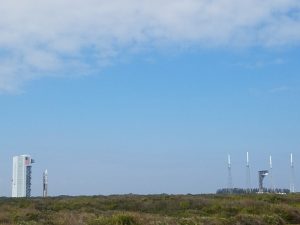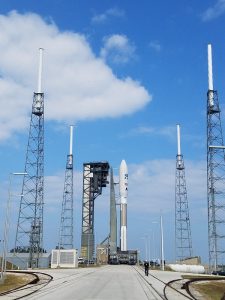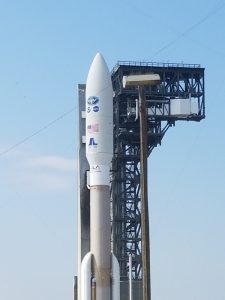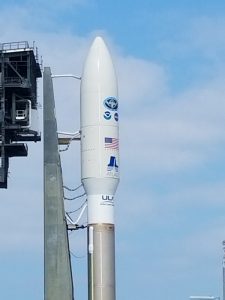
A United Launch Alliance Atlas V rocket rolled out to its launchpad earlier today, taking precious cargo with it: the GOES-R weather satellite.

The GOES-R weather satellite will revolutionize meteorology in the United States, providing scientists with robust data far superior to the data currently received by the third generation GOES satellites that are positioned over North America now.The rocket was wheeled out aboard a mobile launcher platform, emerging from the hangar where the rocket’s two stages and the payload were integrated over the past three weeks.

The slow drive from the 30-story Vertical Integration Facility to the launch pad used a pair of specially-made “trackmobiles” to carry the rocket’s 1.4-million pound launching platform for the 1,800-foot trip. The trip took less than 45 minutes to complete.
The rocket now stands tall among lightning towers which protect it; fortunately, no lightning or any weather issues are expected to impact the launch at this time. In the last official forecast from the Air Force’s 45th Weather Squadron, weather is 90% “GO” for launch during the launch window.

The rocket is scheduled to lift-off during an hour-long launch window that opens at 5:42pm on November 19th.
The GOES-R weather satellite will be carried into space atop United Launch Alliance’s Atlas V rocket in a 541 configuration; every Atlas V version has a three digit ID-Number, with the first digit being the payload fairing diameter, the second digit being the number of solid rocket boosters, and the third digit being the number of RL-10A Engines on Centaur. The last Atlas V in 541 configuration to launch carried the Mars Curiosity Rover into space.

The GOES-R weather satellite will undergo significant testing after a successful launch; normal streams of data from it are not likely before the mid-fall of 2017.
GOES-R will make available 34 meteorological, solar and space weather products available as part of its baseline offering. The Advanced Baseline Imager (ABI) will provide Aerosol Detection (Including Smoke and Dust), Aerosol Optical Depth (AOD), Clear Sky Masks, Cloud and Moisture Imagery, Cloud Optical Depth, Cloud Particle Size Distribution, Cloud Top Height, Cloud Top Phase, Cloud Top Pressure, Cloud Top Temperature, Derived Motion Winds, Derived Stability Indices, Downward Shortwave Radiation, Surface Fire/Hot Spot Characterization, Hurricane Intensity Estimation, Land Surface Temperature (Skin), Legacy Vertical Moisture Profile, Legacy Vertical Temperature Profile, Radiances, Rainfall Rate / QPE, Reflected Shortwave, Radiation: TOA, Sea Surface Temperature (Skin), Snow Cover, Total Precipitable Water, and Volcanic Ash: Detection and Height.
An on-board Geostationary Lightning Mapper (GLM) will provide lightning detection (events, groups, and flashes.) The Space Environment In-Situ Suite (SEISS) will provide Energetic Heavy Ions, Magnetospheric Electrons & Protons: Low Energy, Magnetospheric Electrons & Protons: Med & High Energy, and Solar & Galactic Protons. The Magnetometer (MAG) will provide data of the geomagnetic field. The Extreme Ultraviolet and X-Ray Irradiance Suite (EXIS) will provide data on Solar Flux: EUV, and Solar Flux: X-ray Irradiance. Lastly, the Solar Ultraviolet Imager (SUVI) will provide insights on Solar EUV Imagery.
Visit our other articles on GOES-R:
GOES-R Launch Set for November 19
GOES-R Proving Ground: Learning Satellite Sophistication Pre-Launch